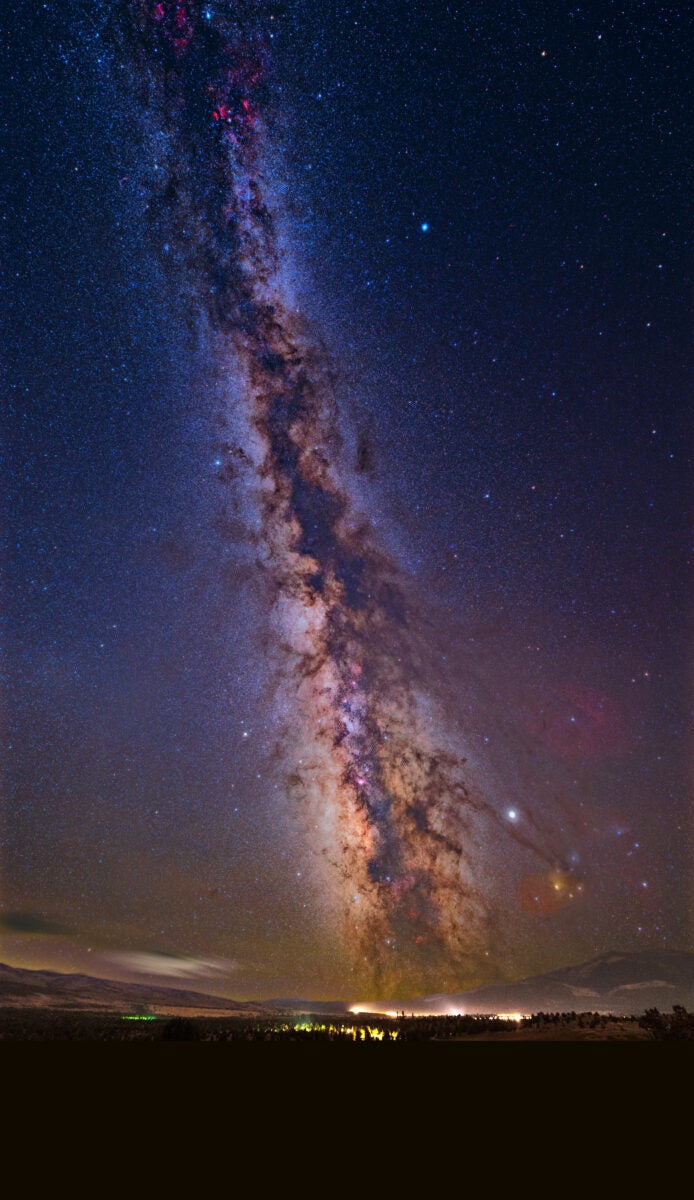
The summer Milky Way was photographed from a hilltop over the Modoc Plateau in California using ten 3-minute exposures and a Sigma Art 14mm lens. All photos were taken with a Nikon D750 DSLR, pre-processed in Adobe Bridge, and post-processed in Adobe Photoshop. Credit: All images by Frank Dibbell
I love taking wide-field images of the night sky. Revealing the hidden depths of a large swath of the heavens in a long-exposure photograph shows me that space isn’t actually empty — it’s filled with unfathomably large amounts of gas and dust. And with today’s cameras and specialized filters, amateurs can produce stunning views of the heavens that exceed what professional observatories could produce just a few short decades ago.
This is especially true in wide-field imaging, which has several advantages over more specialized astroimaging setups. These include cost, portability, and near-immunity to bad seeing — aspects that appeal to beginners and experienced astroimagers alike.
The universe is filled with wondrous sights, and wide-field imaging technology can display it all in living color.
Best beginner systems
One reason wide-field imaging is so compelling is that you don’t need a lot of expensive equipment to make great images. A DSLR camera on an equatorial tracking platform with a wide-angle lens is perfect for a shot of the Milky Way — whether it’s solely overhead or framed against a panoramic background, such as a mountain range or desert plain.
You can also capture wide-field telescopic views. There are a number of telescope manufacturers who make refractors with short focal lengths, typically 50mm to 80mm in aperture with focal ratios ranging from f/4.5 to f/6. These make efficient lenses for shooting wide-field subjects when paired with a DSLR, mirrorless, or CMOS imaging camera with at least an APS-C-sized sensor. Mount this gear on a small equatorial mount paired with an off-axis guider or external guide scope, and you’ll have yourself a wonderful wide-field imaging system. My favorite wide-field system uses a 71mm refractor with an APS-C-sized CMOS camera on a small equatorial mount.
Whether you have a small refractor with a dedicated camera or an equatorial platform and DSLR, both combinations are highly portable, relatively easy to set up, and can produce stunning images in a single evening under the stars. This is an important aspect to consider if you are like me and must travel to a dark-sky site. When you can only spend a single evening in a location, shooting a wide-field subject becomes a perfect goal.
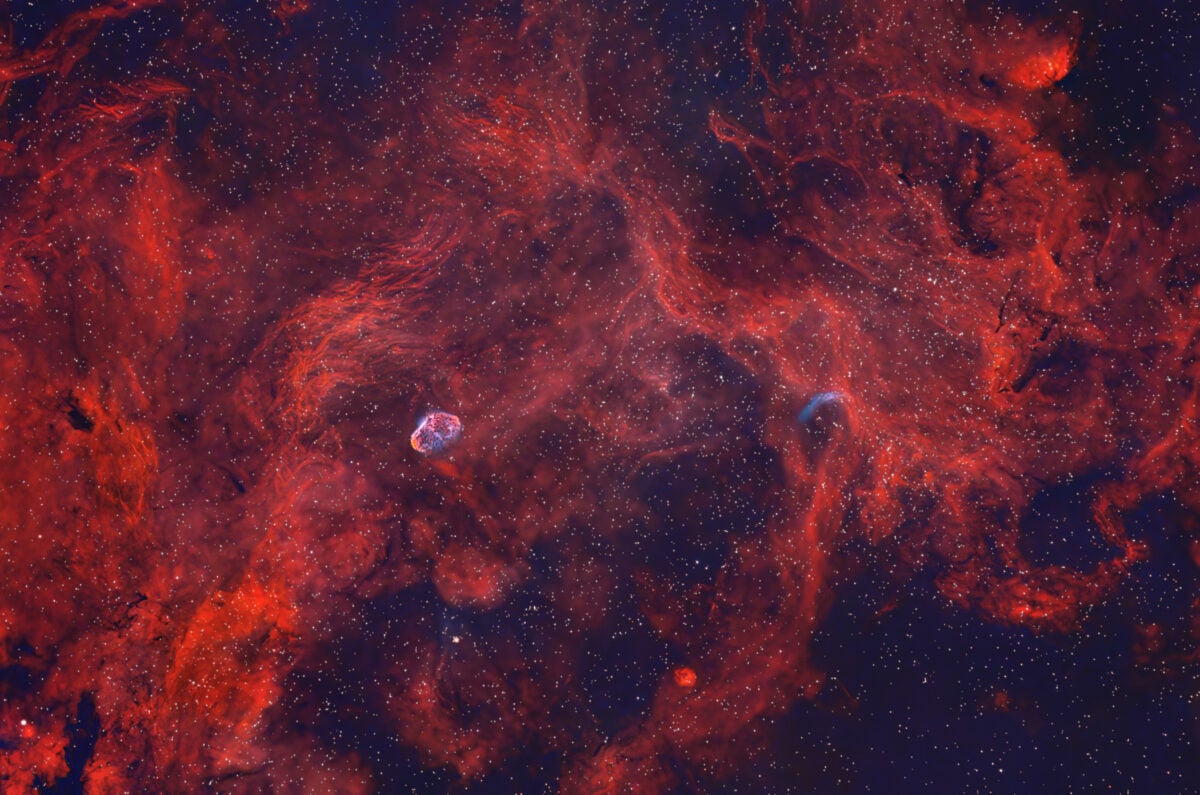
Pick your battles with the sky
In all forms of astronomy, our atmosphere dictates what we can and cannot do every night. In addition to the obvious issues like clouds, the atmosphere can also present limits to transparency (dust, smoke, and water vapor) and seeing (turbulence). As far as clouds and transparency go, sadly there is nothing to be done. But seeing, on the other hand, we can do something about. This is where wide-field images come perfectly into play.
On nights when the seeing is below average, the short focal lengths of wide-field imaging systems do very well. These systems may have image scales of 4 to 6 arcseconds per pixel, whereas a more traditional imaging platform may have image scales of 0.5 to 2 arcseconds per pixels. A night of below-average seeing, where the atmosphere limits resolution to 4 or 5 arcseconds, will sideline the traditional imaging system. But a wide-field system with an image scale larger than the seeing resolution will not be affected. This immunity from below-average seeing is perhaps the biggest benefit of all.
One of my favorite wide-field imaging systems consists of my astromodified Nikon D750 mounted on an equatorial tracking platform. This is perfect for shooting wide vistas of the Milky Way and celestial visitors like bright comets. It is highly portable and fits into a backpack. I have used this system a number of times when circumstances dictated a hike to the best spot for a photo. One example was when I captured the summer Milky Way from a hilltop over the Modoc Plateau in northeastern California (page 40). For this wide-field shot, I used my Nikon D750 with a Sigma Art 14mm lens on an AstroTrac equatorial tracking platform.
Another photo location requiring a bit of a hike was the image I took of Comet C/2020 F3 (NEOWISE; see image at top left). This was shot with a Nikon D750 and the Rokinon 24mm lens carried on a Vixen Polarie equatorial tracking platform. Being highly portable is one great advantage of a wide-field system!
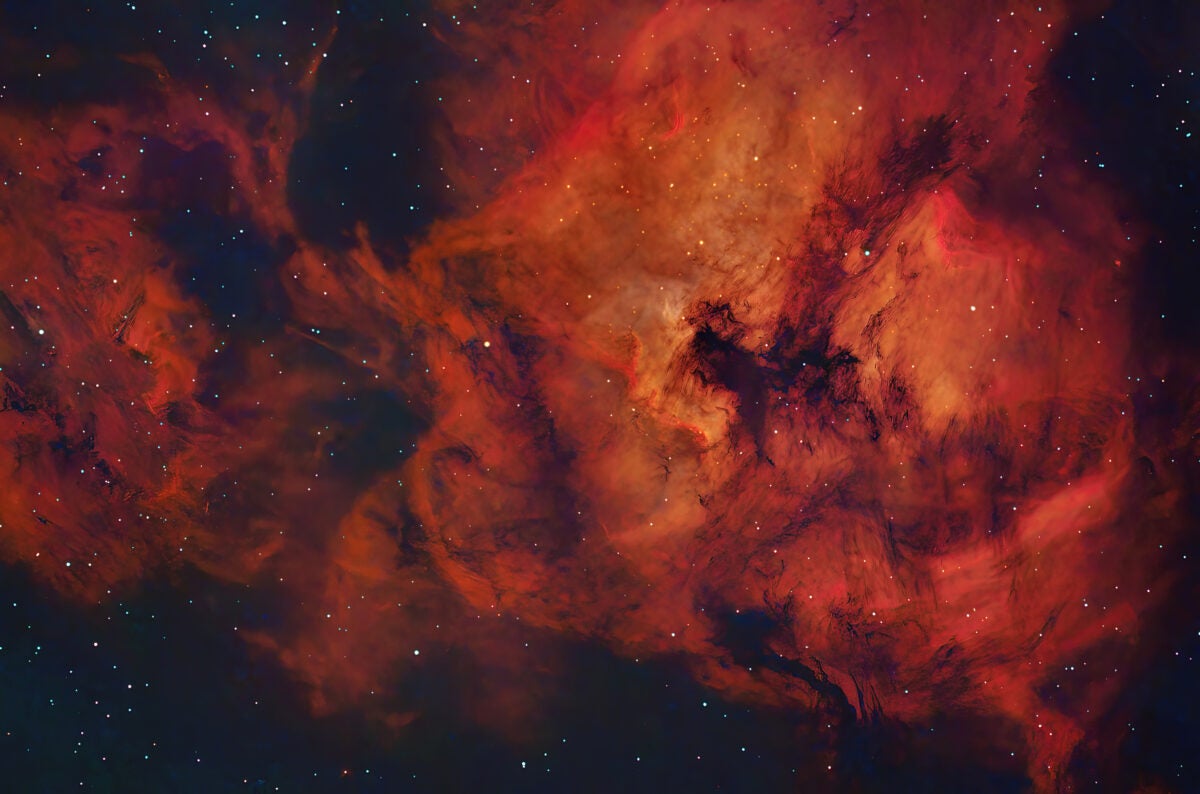
The sky is your oyster
Constellations are also excellent wide-field targets. Orion is a marvelous candidate because there are several objects within its boundaries to surprise you. This area is rich with ionized hydrogen, so I added a 12nm clip-in Hydrogen-alpha (Hα) filter to my Nikon specifically to capture all of Barnard’s Loop (Sharpless 2–276), as well as the famous Orion Nebula (M42) and Horsehead Nebula (Barnard 33). With a Sigma Art 85mm lens on an equatorial platform, I took five-minute Hα exposures and three-minute RGB exposures (bottom-left photo on page 42).
Another favorite wide-field system of mine consists of an Askar 200mm f/4 Astro lens paired with my Nikon D750 DSLR and an Optolong L-Ultimate filter, which passes Hα and Oxygen-III (OIII) wavelengths. For this setup, I use a small equatorial mount for guiding and imaging.
During the summertime, around June, the constellation Cygnus is perfectly positioned to take wide-field shots of its various sections. One highlight is the Sadr Region in Cygnus (top-right on page 43), a field roughly 6° by 9°. The region features rich nebulosity as well as objects such as the Crescent Nebula (NGC 6888), the blue-colored shock wave from the Wolf-Rayet star known as WR 134, and the Tulip Nebula (Sharpless 2–101).
Another popular area of Cygnus for a wide-field imager is the North America Nebula complex. This field is saturated with ionized hydrogen — so much so that the North America Nebula (NGC 7000) and its companion, the Pelican Nebula (IC 5070), can appear lost in an undulating red sea (top left).
My largest wide-field system pairs a 71mm f/4.5 refractor with my APS-C-sized CMOS camera — it provides extreme detail and the option of taking wide-field panoramas. Adding a filter wheel to the monochrome CMOS camera allows more flexibility when processing the image. I personally like to shoot with the Hα and OIII filters to create a bicolor image of nebulosity, then shoot with RGB filters to capture the colors of the background stars in the field. I photographed the Veil Nebula complex (bottom left) with this system, combining my bicolor Hα/OIII exposures and the proper star colors from the exposures with my RGB filter set. Note that there are many techniques for these activities, it’s all about experimenting and finding the one that works best.
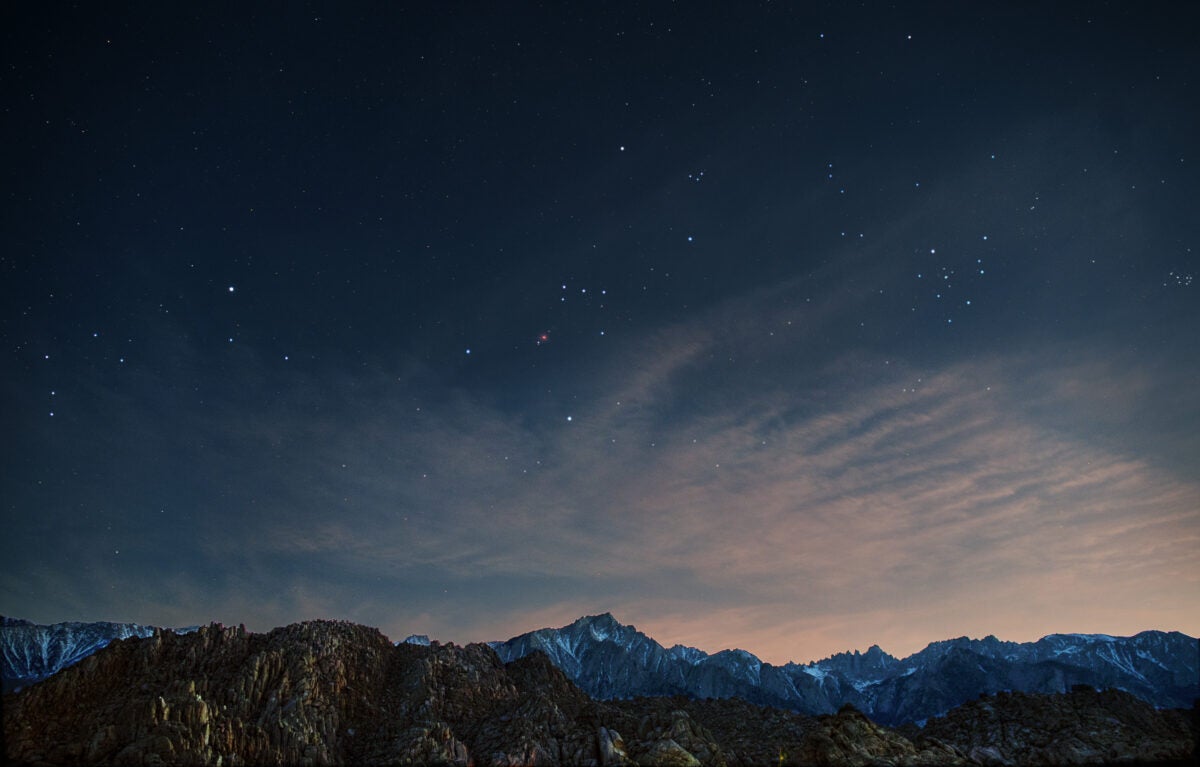
A broader view
From time to time, nature will intervene and do its best to mess up a wide-field session. One moment you’re setting up your system for the perfect shot; the next, you see multiple clouds magically appear.
This very scenario occurred on a trip I took to photograph the winter Milky Way setting over California’s Mount Whitney. I set up my equipment at sunset and waited patiently for dark, but then clouds started forming. It was clear that soon there would be no Milky Way to see, much less photograph. But when you’re shooting a wide field, you have the flexibility to improvise. As you can see in the photo above, I may not have captured my Milky Way shot but I still captured a beautiful photo of the constellation Orion setting over the peak, with the clouds as an integral part of the picture.
Wide-field imaging is a great way for a beginner to start out in astroimaging, but that’s not the only reason to do it: No matter your skill level, learning how to photograph in wide-field gives you a wonderful supplement to more traditional narrow-field views. By portraying celestial objects in their larger surroundings, we can gain a different perspective of the sky overhead, and see our wondrous universe as a grand vista.
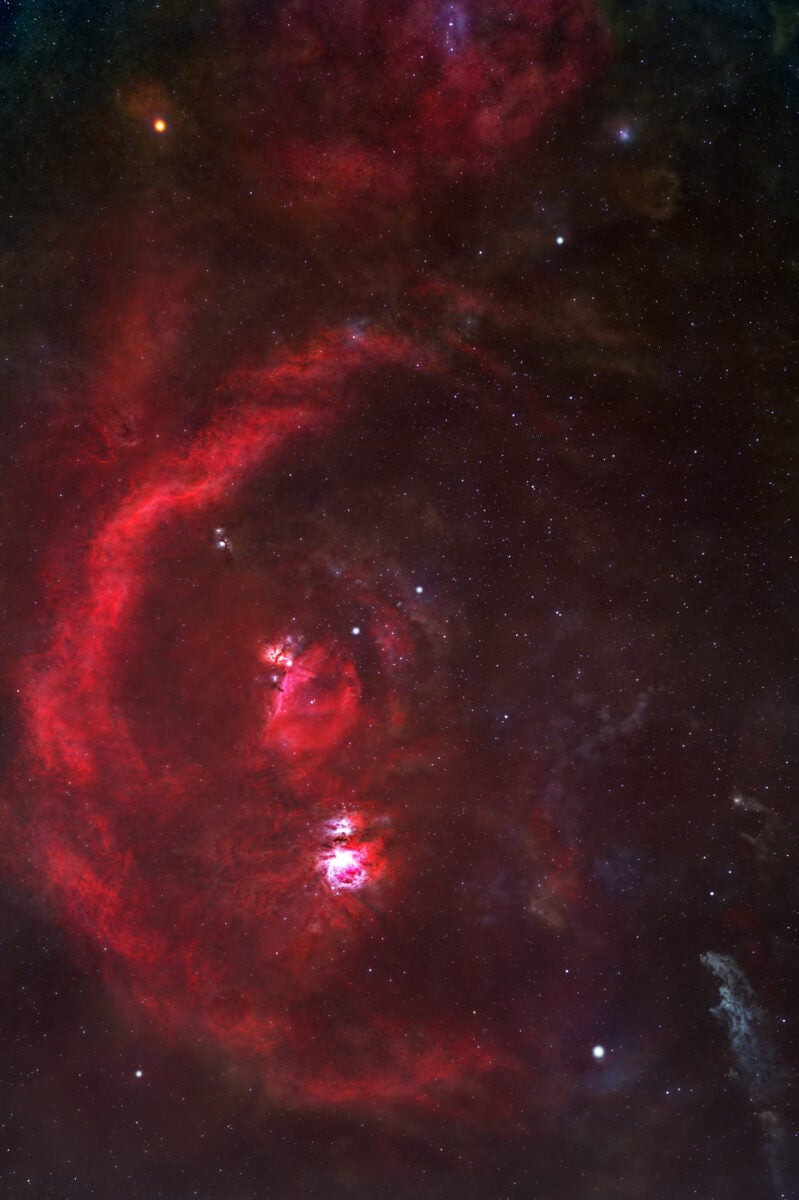
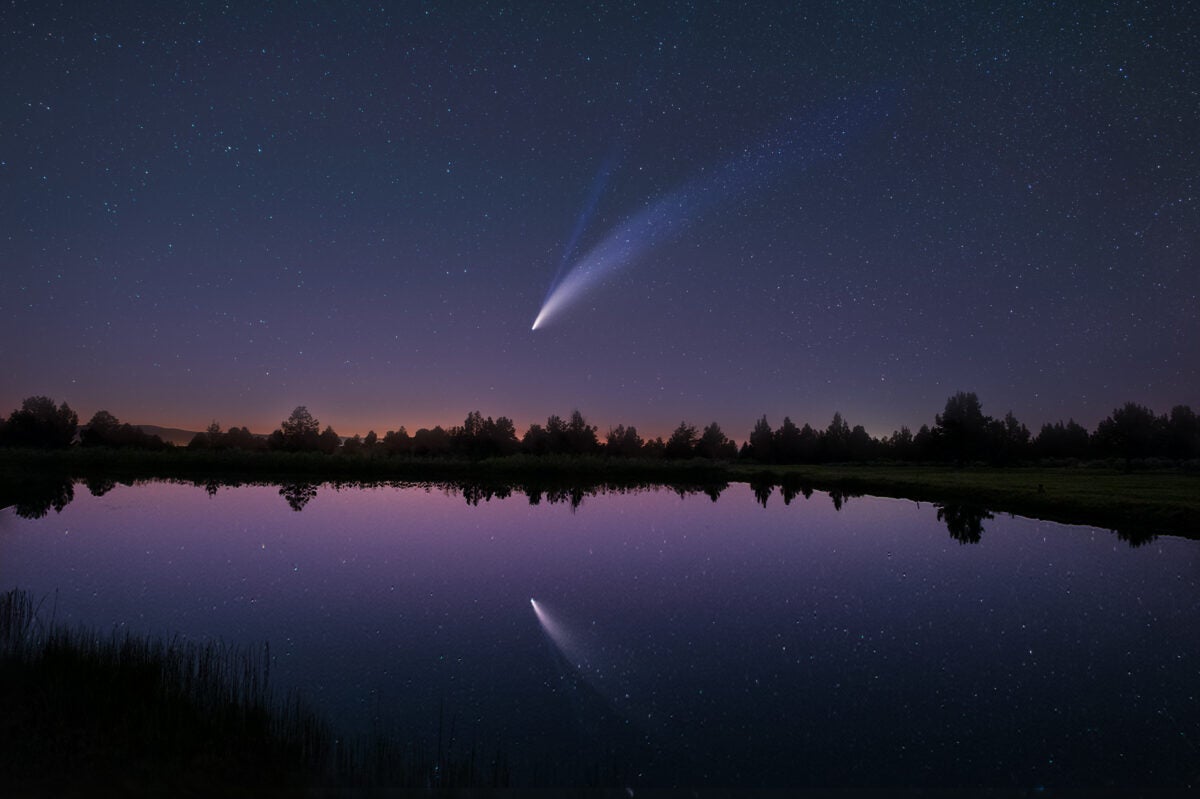
second exposures were taken for the comet and one 30-second exposure was taken for the foreground.
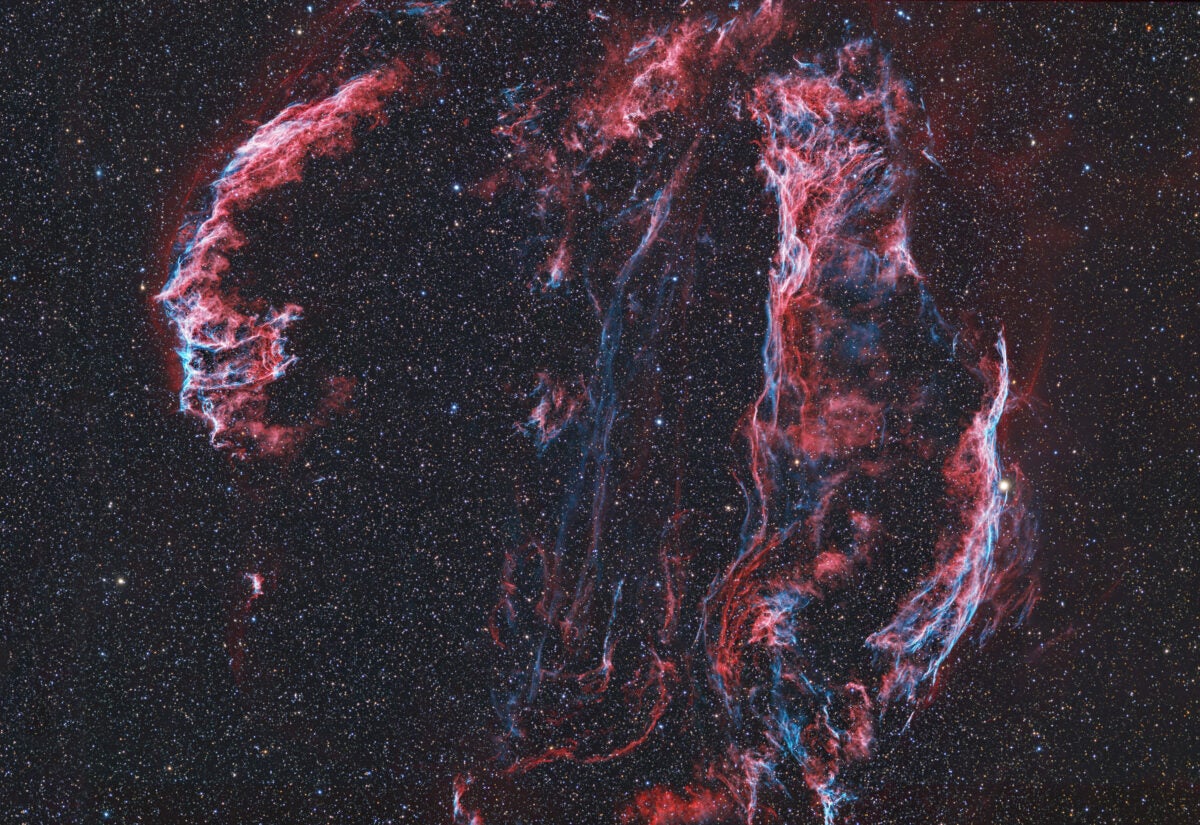
A word on wide fields
It’s difficult to pin down a precise definition of a wide field on the night sky. But for me, a wide-field image is one that encompasses a minimum area of approximately 4 square degrees, or about eight Full Moons side-by-side. An image of this scale will perfectly frame the North America Nebula (NGC 7000) and its companion the Pelican Nebula (IC 5070) in a field rich with glowing clouds of hydrogen.
When your field becomes extremely wide, you find yourself in the realm of nightscapes — images of the night sky that may also include terrestrial vistas, like Orion and the winter Milky Way setting over Mount Whitney in California’s Sierra Nevada shown on page 45. Other astrophotographers consider these to be wide-field images as well.

